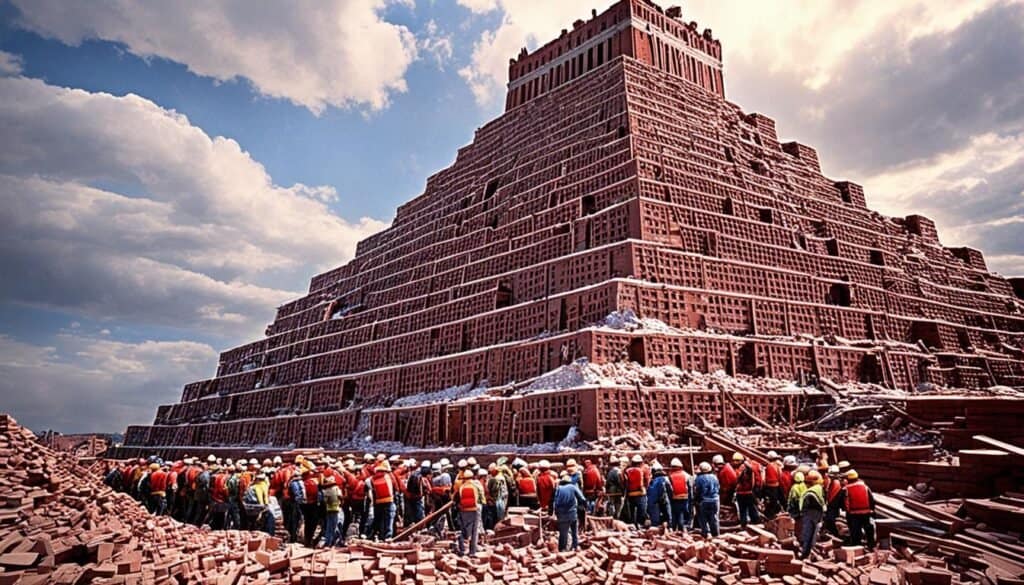Have you ever thought about how our ancient stories were told? How did they mix promises from the divine with the beauty of creation? Let’s look at Genesis to see the rich pictures in words it uses. This book shows a picture of where we came from and the special bond between God and us. Get ready to be amazed by the deep meaning in these old words.
Key Takeaways:
- Genesis is filled with vibrant word pictures that bring the stories of creation and early human history to life.
- These vivid images convey deeper meanings and truths about God, humanity, and the world.
- Some of the key word pictures in Genesis include the breath of life, the Garden of Eden, the serpent, Noah’s ark, Jacob’s ladder, and more.
- Exploring these word pictures can deepen our understanding of the biblical narratives and their relevance to our lives today.
- Join us as we unravel the beauty and significance of these vivid word pictures in Genesis.
The Breath of Life
In Genesis 2:7, a deep word picture is painted. It tells us God made man from dust. Then He breathed life into him. This shows us life has a divine start.
Thinking about this scene is awe-inspiring. The simple process of taking a breath becomes a sacred moment. The picture reminds us we are here for a special reason.
“And the LORD God formed man of the dust of the ground, and breathed into his nostrils the breath of life; and man became a living soul.” – Genesis 2:7
Picture God gently forming a man from the earth and then breathing life into him. This act demonstrates God’s love for us in such a deep way. It’s about more than just existence.
This scene shows how closely we are tied to our Creator. We’re more than just bodies; we’re bearers of the breath of life. And every breath we take connects us to the divine source.
A Divine Act
The act of giving us breath is key to what makes us unique. It shows our great value. We are not a cosmic accident. We are made with purpose and care, set apart from all else.
Many spiritual beliefs link breath with the soul. It is seen as what makes us truly alive and able to know the divine. Breathing is more than just staying alive; it’s about being connected with something greater.
Reflecting on Genesis 2:7, let’s value our breath and life-giving diversity. Our birth was not by chance but with purpose. Let’s respect and honor our breath as a living symbol of our worth.
A Visual Representation
Now, think of a painting that captures the scene of God giving life to man. The details and colors make it really come alive.
| Table: Artistic Representation of the Breath of Life |
|---|
This painting brings awe and wonder to the story. It helps us see the breath of life in a fresh light. Art lets us truly grasp the beauty and power of creation.
The Garden of Eden
In Genesis 2:8-9, the Garden of Eden is presented as a perfect paradise. It overflows with beauty and unlimited natural treasures. Here, every tree offers both stunning looks and delicious food, making it a feast for the eyes and the taste buds.
Within this beautiful place are two special trees. The tree of life means to live forever and stay close to God. The tree of the knowledge of good and evil shows our ability to choose right from wrong.
Imagine walking through paradise, vibrant trees all around. Their leaves sparkle in the sunlight. The air is filled with the sweet scent of flowers. You can almost taste the perfect, juicy fruits. This scene shows God’s amazing gifts and the flawless nature of His work.

“The Lord God planted a garden in Eden, in the east, and placed the man there. He made every tree that looks good and provides food grow…”
This sanctuary marks the start of humanity’s story. Adam and Eve enjoy a perfect life near God here. The Garden shows the ideal connection between humans and their Creator, filled with endless blessings.
But, the sequel reveals a dark turn in this story. Forbidden knowledge leads to a fall. The tale of Eden is a warning about the dangers of our desires. It reminds us of the importance of our link with God and wise choices.
Let us admire God’s initial masterpiece in Eden. Let’s cherish its beauty and God’s generous gifts to us. And let’s learn from this ancient story to follow God’s path, valuing the peace that comes with His presence.
The Serpent
In Genesis 3:1, we meet the serpent, a sly creature central to human’s loss of innocence. It leads us to think about trust and the price of giving in to wrong urges. This part of the Bible offers deep truths and warnings we can still learn from today.
Genesis 3:1 talks about the serpent, calling it “crafty” and the most cunning of creatures. It tempts Eve, starting a talk that results in choosing to eat from a forbidden tree.
“Now the serpent was more subtle than any of the beasts of the field, which the Lord God had made. And he said unto the woman, ‘Yea, hath God said, Ye shall not eat of every tree of the garden?'” – Genesis 3:1
The serpent is a timeless symbol of trickery and the start of human disobedience. It warns us against the dangers of giving in to wrong desires. This famous scene is a lesson in staying true to what is right and avoiding traps that can lead us off course.
The story shows how the serpent took advantage of Eve’s trust. It stands for all the things that can lure us into doing wrong. This tale teaches us to be careful and to keep to right paths, following what is good.
Thinking about the serpent reminds us to watch out for things that trick us. If we stick to our beliefs, stay true to what’s right, and are smart in our choices, we’ll avoid many dangers. God’s wisdom and care will keep us safe as we face life’s challenges.
Cain’s Offering
In Genesis 4:3-5, Cain and Abel offer different gifts to the Lord. Cain, a farmer, gives fruits. Abel, a shepherd, offers his best sheep. This story makes us think about why we give.
It’s a lesson on dealing with jealousy and making the right choices. When God likes Abel’s gift more, Cain is jealous. This story warns against letting envy and bad feelings guide our actions.
This tale makes us question our own giving. It asks if our actions come from a true heart. It makes us wonder if we’re really trying our best.
“The Lord looked with favor on Abel and his offering, but on Cain and his offering He did not look with favor. So Cain became very angry, and his countenance fell.” – Genesis 4:4-5
This story shows that God sees what’s in our hearts. It encourages us to check why we give. It’s about being humble, thankful, and loving when we offer.
| Key Symbolism | Cain’s Offering | Abel’s Offering |
|---|---|---|
| Sacrificial Act | Offering the fruits of the soil | Offering the firstborn of the flock with their fat portions |
| Motivation | Possibly motivated by duty or expectation | Offering the best and most valuable |
| Response from God | Did not look with favor | Accepted and looked with favor |
| Consequence | Anger, jealousy, and the path to sin | Divine acceptance and favor |
This is a story we learn from. It’s not just about what we give. It’s about the love and respect we show God. Let’s devote our lives and what we have to making God happy and thankful.
Continue reading to discover more vivid word pictures in Genesis that reveal profound truths about our origins, faith, and relationship with God.

Noah’s Ark
In Genesis 6:14-16, the story of Noah’s ark begins. Noah was asked by God to build this amazing ark. It shows Noah’s strong faith and how God kept them all safe during a huge flood.
This wasn’t just any boat. It was a huge, carefully designed wooden ark. God told Noah exactly how to build it. This made sure the ark was strong enough to float and keep everyone safe.
God told Noah to bring two of every animal on board. This showed how different creatures can work together. It also points out how much God cares for all life.
“And this is how you are to build it: The ark is to be three hundred cubits long, fifty cubits wide, and thirty cubits high. Make a roof for it, leaving below the roof an opening one cubit high all around…” (Genesis 6:14-16)
When the flood came, the ark was the only safe place. It was a strong shelter. Inside, Noah’s family and the saved animals were protected from the huge flood. The ark was a sign of new beginning, saving the world from total ruin.
Noah’s ark stands for more than just escaping the flood. It shows God’s care for those who follow Him. Noah’s story highlights the importance of trust and following God’s guidance, no matter what others say.

The tale of Noah’s ark still moves and interests people today. It’s about faith, doing what God asks, and how God protects us. Just like Noah’s family, we can find peace in God’s care during life’s challenges.
The Tower of Babel
Genesis 11:3-4 tells a story of big dreams and sudden changes. People wanted to build a city and a tower to the sky. This tower showed their dream to be great and high above all.
But, God mixed up their words, stopping their work. This showed people that their dreams had a limit and they needed to remember their place. It was a lesson in staying humble before a greater power.
“Come, let us go down and confuse their language so they will not understand each other.” – Genesis 11:7
This tale warns about the danger of too much pride and why it’s important to know our limits. It’s a lesson in understanding that we are small compared to the universe and a warning to never forget that.
Now, let’s compare the tower of Babel with other famous bible stories at a glance:
| The Tower of Babel (Genesis 11:3-4) | Noah’s Ark (Genesis 6:14-16) | Pharaoh’s Dreams (Genesis 41:1-7) | |
|---|---|---|---|
| Main Theme | Human ambition and divine intervention | Divine judgment and salvation | Divine foresight and interpretation |
| Key Symbol | Tower reaching the heavens | Massive wooden ark | Seven fat cows and seven lean cows |
| Divine Role | Confusing languages | Sending a flood | Granting divine wisdom |
The tower of Babel’s story is very unique among others. It talks about our hopes and dreams and how there’s always a limit to what we can achieve. This message is timeless, always reminding us of the balance between our own plans and the will of a higher power.
Lessons from the Tower of Babel
This story teaches us a few important things:
- Stay humble: Know that there are some things we can’t do.
- Communication is key: Working together and understanding each other is vital.
- Remember who’s in charge: Recognize the power of a greater authority.
Remember these lessons as we keep reading about the powerful images in Genesis.

Let’s keep exploring Genesis. There’s a lot to learn from its stories, showing us where we come from and the promises that guide us.
Abraham’s Stars
In Genesis 15:5, God takes Abraham outside to see the stars. He tells him his descendants will be as many as the stars. This shows how big God’s promises are and the great future waiting for Abraham’s family.
When we look at the stars at night, it’s hard not to be amazed. Each star is like a fulfilled promise or a future story. Just like the stars, Abraham’s family will also bring light to the world with their faith and work.
“Look up at the sky and count the stars if you can. Just so,” urged God, “shall your descendants be.” – Genesis 15:5
This story makes us feel connected to a big story, made by a loving God. Each person is like a star, with their own role and promise. We’re part of a long line, going all the way back to the beginning.
Embracing the Promise
Abraham’s faith in God was strong and unwavering. Even though he was old and Sarah was unable to have kids, he believed God’s promises. The stars were a daily reminder of God’s trustworthiness and Abraham’s future.
We can also learn from Abraham by holding onto God’s promises. Just as stars brighten the night sky, these promises light our way. They offer us hope and guide us to a life filled with meaning and purpose. With God, we can overcome anything, knowing His promises are true.
When you look at the stars next, think about Abraham’s faith and God’s promises. Remember the potential within you. Let your life shine like a star, bringing light, faith, and love to the world.
Jacob’s Ladder
Genesis 28:12 tells of a dream Jacob had. In this dream, he sees a ladder from earth reaching to heaven. Angels are going up and down the ladder. This dream shows us God’s strong connection to people. And it gives us a hint about the spiritual world.
The ladder in Jacob’s dream is like a phone line between God and us. Angels going up and down tell us something important. They show that God is always interacting with our world. This means He cares about every person and everything that happens.
Jacob’s ladder is more than a dream. It shows God is close to us. He’s not far away, but right here, ready to listen and help. Just like in Jacob’s dream, we can feel God near us. We know He’s with us, supporting us on our faith journey.
“Surely, the Lord is in this place, and I did not know it!” – Genesis 28:16
This ladder reminds us that God is faithful. It encourages us to look for God in our daily lives. And it teaches us the power of meeting God face to face.
Symbolism of Jacob’s Ladder
Now, let’s look at the deeper meaning of Jacob’s ladder:
| Symbol | Meaning |
|---|---|
| Ladder | Shows the close link between heaven and earth. It shows that God is close to us. |
| Angels | Are God’s messengers. They interact with us and carry out God’s plans. |
| Ascending and Descending | Mean a constant, active link between God and our world. |
Jacob’s ladder’s meaning deepens our knowledge. It tells us how much God cares for us. He wants to talk to us. He wants us to know Him closely.
Joseph’s Coat of Many Colors
In the book of Genesis, we meet Joseph, a young man on a surprising journey. His life is changed by his coat of many colors. This coat stands out in Joseph’s life story, shaping his future in a big way.
Jacob, Joseph’s dad, gives him a special coat in Genesis 37:3. It’s not just any coat, but a robe full of colors and patterns. This gift shows Joseph is special to his father.
Joseph’s brothers get jealous of his favored status because of the coat. Their envy leads to a terrible plan against Joseph. This plan causes him to be sold into slavery and taken away from his family.
The story of Joseph’s coat shows us lessons about jealousy, parental favoritism, and life’s challenges. It reminds us not to judge others by what they have. Material things can affect relationships negatively, bringing hardship.
“Joseph’s coat of many colors became a visible expression of his father’s love and favor. However, it also became a source of strife and hardship for Joseph. Let us be cautious of the potential harm that can arise from favoritism and envy in our own lives.”
Joseph overcomes his struggles with faith. He goes from slave and prisoner to Pharaoh’s trusted advisor. In the end, he saves his family from famine. The coat reflects Joseph’s journey of resilience and divine destiny.
Lessons from Joseph’s Coat:
- Individuality: The coat echoes each unique thread, inspiring us to celebrate our own special traits.
- Family dynamics: It highlights family challenges and the harm of favoritism, urging us to promote love and fairness in our families.
- Overcoming adversity: Joseph’s story encourages us to endure life’s tests, believing in a bigger plan.
Joseph’s coat is a lasting image of love, envy, and God’s plan. It shows how a young man triumphs over hardship to fulfill his purpose. It brings hope for the future.
How Do Poetic Hymns and Songs in Genesis Enhance the Vivid Word Pictures Found in the Text?
Exploring the hymns and songs in genesis enriches the narrative’s imagery, breathing life into divine creation and human emotion. These poetic elements create vivid word pictures, transforming abstract concepts into relatable experiences. The lyrical quality enhances the reader’s connection, making the ancient text resonant and memorable through its rhythmic beauty.
Pharaoh’s Dreams
In Genesis 41:1-7, we read about Pharaoh’s dreams. He dreams of seven fat cows and seven lean cows. He also sees seven healthy ears of grain and seven thin ears. This dream makes Pharaoh feel worried. He thinks there must be a hidden message in these strange images.
Pharaoh asks Joseph to explain the dream. Joseph is famous for reading dreams with God’s help. Joseph tells Pharaoh the dreams mean there will be seven years of plenty. Then, there will be seven tough years with very little food.
Joseph’s wisdom shows the power of understanding the future. It helps Egypt get ready for hard times. This ancient story is important. It shows how God’s plans and people’s actions can work together.
The tale of Pharaoh’s dreams is a lesson on faith and understanding God’s messages. It tells us dreams can be a way for the divine to communicate. Even when they seem puzzling, they offer deep lessons.
Affiliate Disclosure: "As an Amazon Associate I earn from qualifying purchases made from links in this post. We are a participant in the Amazon Services LLC Associates Program, an affiliate advertising program designed to provide a means for us to earn fees by linking to Amazon.com."

